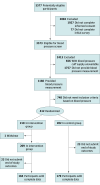Association of a Smartphone Application With Medication Adherence and Blood Pressure Control: The MedISAFE-BP Randomized Clinical Trial
- PMID: 29710289
- PMCID: PMC6145760
- DOI: 10.1001/jamainternmed.2018.0447
Association of a Smartphone Application With Medication Adherence and Blood Pressure Control: The MedISAFE-BP Randomized Clinical Trial
Erratum in
-
Missing Acknowledgment.JAMA Intern Med. 2018 Jun 1;178(6):876. doi: 10.1001/jamainternmed.2018.2297. JAMA Intern Med. 2018. PMID: 29799946 Free PMC article. No abstract available.
Abstract
Importance: Medication nonadherence accounts for up to half of uncontrolled hypertension. Smartphone applications (apps) that aim to improve adherence are widely available but have not been rigorously evaluated.
Objective: To determine if the Medisafe smartphone app improves self-reported medication adherence and blood pressure control.
Design, setting, and participants: This was a 2-arm, randomized clinical trial (Medication Adherence Improvement Support App For Engagement-Blood Pressure [MedISAFE-BP]). Participants were recruited through an online platform and were mailed a home blood pressure cuff to confirm eligibility and to provide follow-up measurements. Of 5577 participants who were screened, 412 completed consent, met inclusion criteria (confirmed uncontrolled hypertension, taking 1 to 3 antihypertensive medications), and were randomized in a ratio of 1:1 to intervention or control.
Interventions: Intervention arm participants were instructed to download and use the Medisafe app, which includes reminder alerts, adherence reports, and optional peer support.
Main outcomes and measures: Co-primary outcomes were change from baseline to 12 weeks in self-reported medication adherence, measured by the Morisky medication adherence scale (MMAS) (range, 0-8, with lower scores indicating lower adherence), and change in systolic blood pressure.
Results: Participants (n = 411; 209 in the intervention group and 202 controls) had a mean age of 52.0 years and mean body mass index, calculated as weight in kilograms divided by height in meters squared, of 35.5; 247 (60%) were female, and 103 (25%) were black. After 12 weeks, the mean (SD) score on the MMAS improved by 0.4 (1.5) among intervention participants and remained unchanged among controls (between-group difference: 0.4; 95% CI, 0.1-0.7; P = .01). The mean (SD) systolic blood pressure at baseline was 151.4 (9.0) mm Hg and 151.3 (9.4) mm Hg, among intervention and control participants, respectively. After 12 weeks, the mean (SD) systolic blood pressure decreased by 10.6 (16.0) mm Hg among intervention participants and 10.1 (15.4) mm Hg among controls (between-group difference: -0.5; 95% CI, -3.7 to 2.7; P = .78).
Conclusions and relevance: Among individuals with poorly controlled hypertension, patients randomized to use a smartphone app had a small improvement in self-reported medication adherence but no change in systolic blood pressure compared with controls.
Trial registration: clinicaltrials.gov Identifier: NCT02727543.
Conflict of interest statement
Figures
Comment in
-
Building a Stronger Care Loop Through mHealth Technology.JAMA Intern Med. 2018 Jun 1;178(6):809-811. doi: 10.1001/jamainternmed.2018.1168. JAMA Intern Med. 2018. PMID: 29710104 No abstract available.
References
-
- de Oliveira-Filho AD, Costa FA, Neves SJ, de Lyra Junior DP, Morisky DE. Pseudoresistant hypertension due to poor medication adherence. Int J Cardiol. 2014;172(2):e309-e310. - PubMed
-
- Rehman H, Kamal AK, Morris PB, Sayani S, Merchant AT, Virani SS. Mobile Health (mHealth) technology for the management of hypertension and hyperlipidemia: slow start but loads of potential. Curr Atheroscler Rep. 2017;19(3):12. - PubMed
Publication types
MeSH terms
Substances
Associated data
LinkOut - more resources
Full Text Sources
Other Literature Sources
Medical
Miscellaneous



